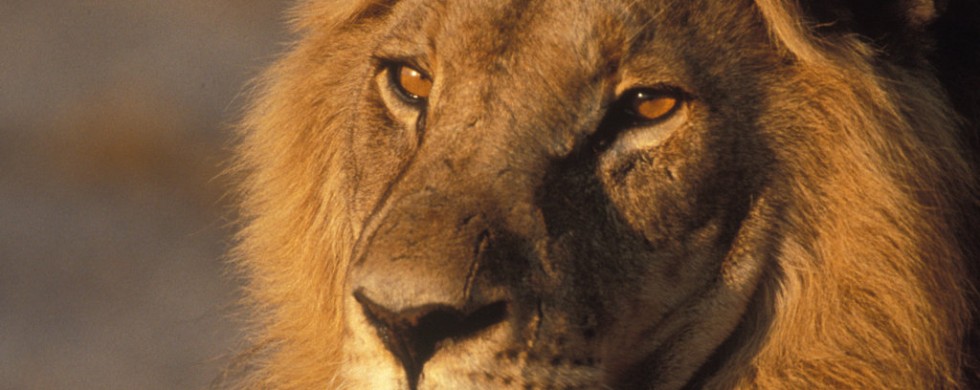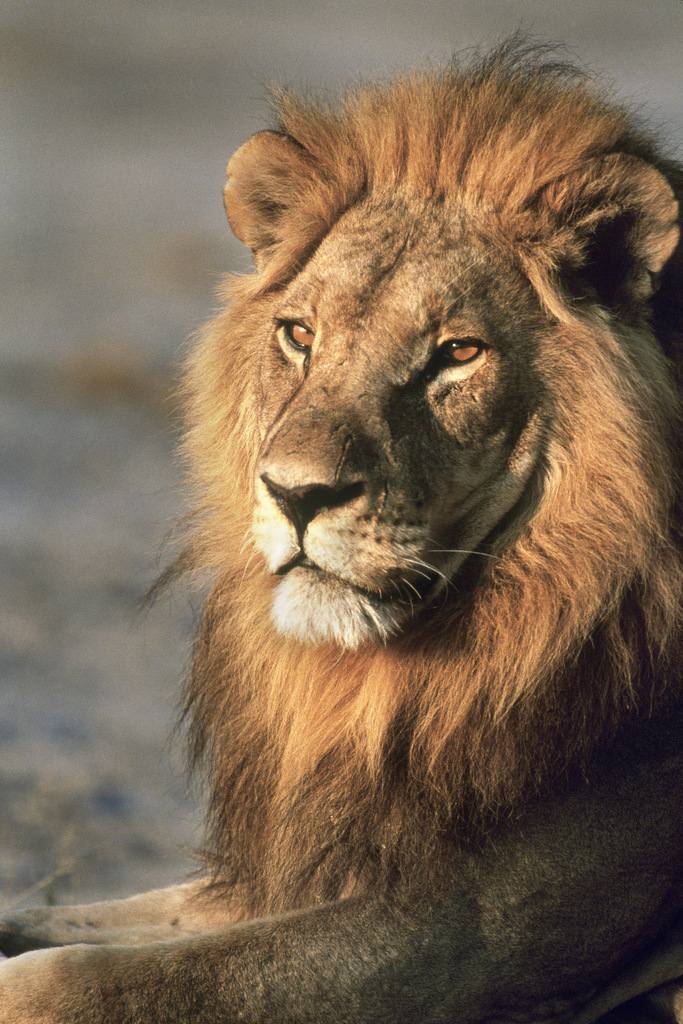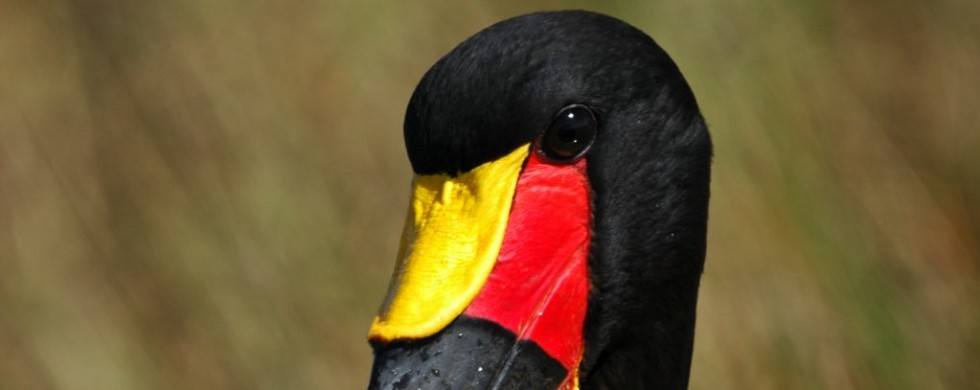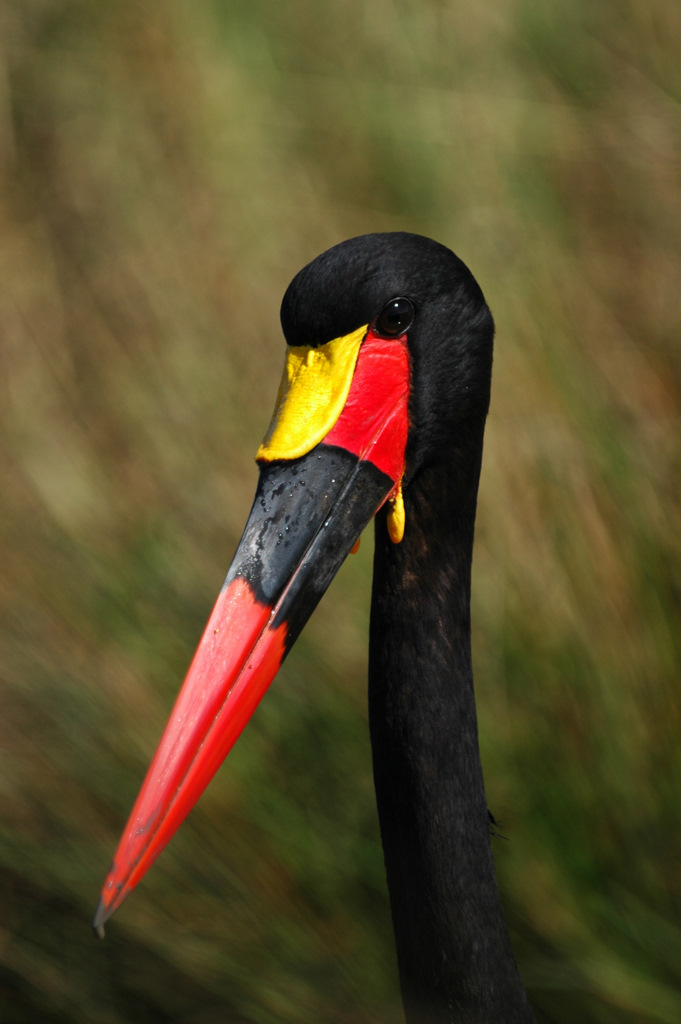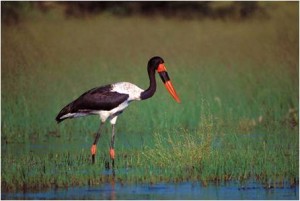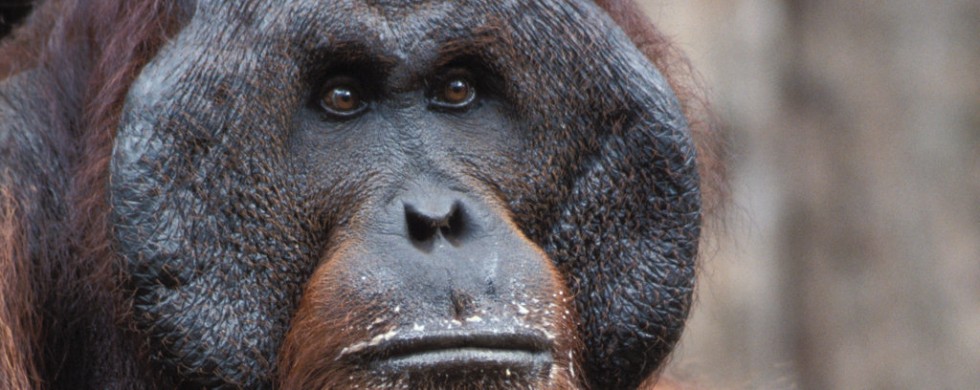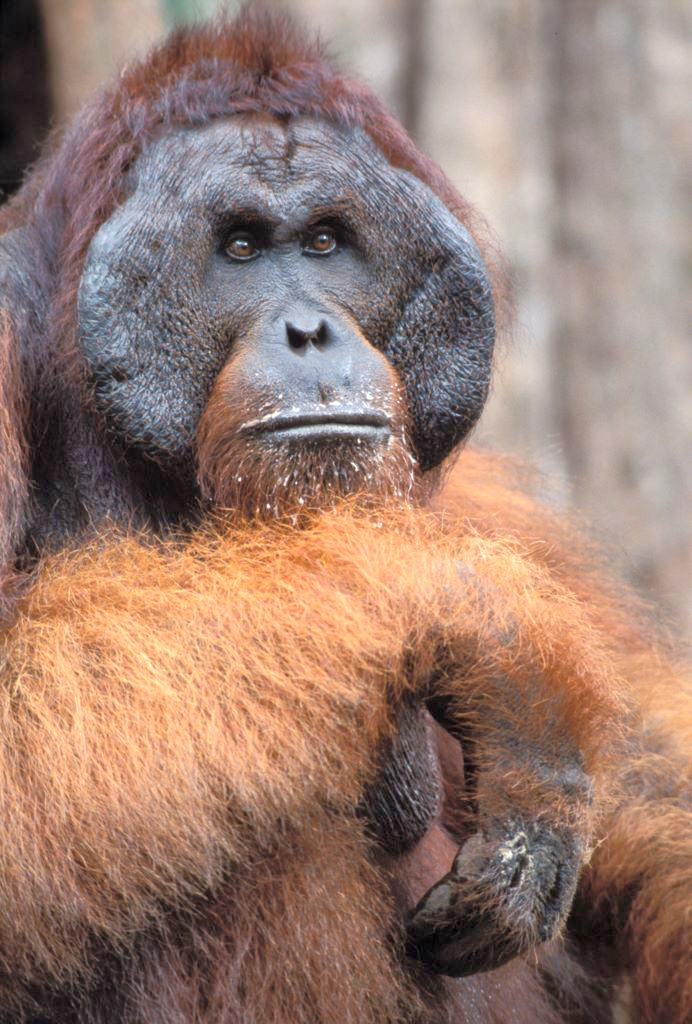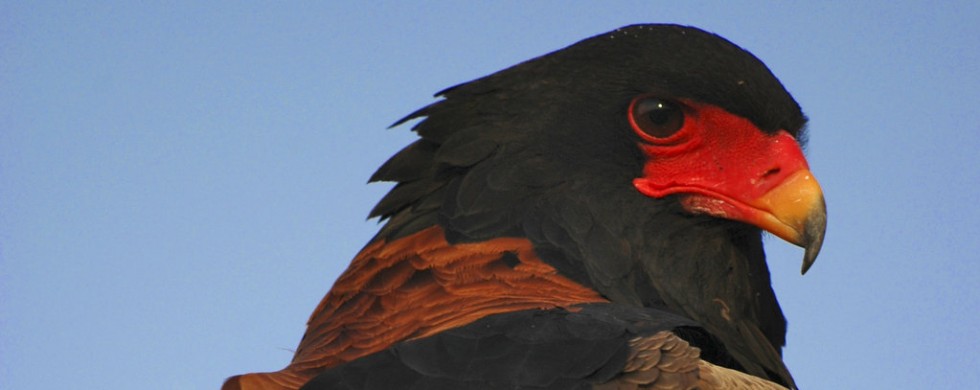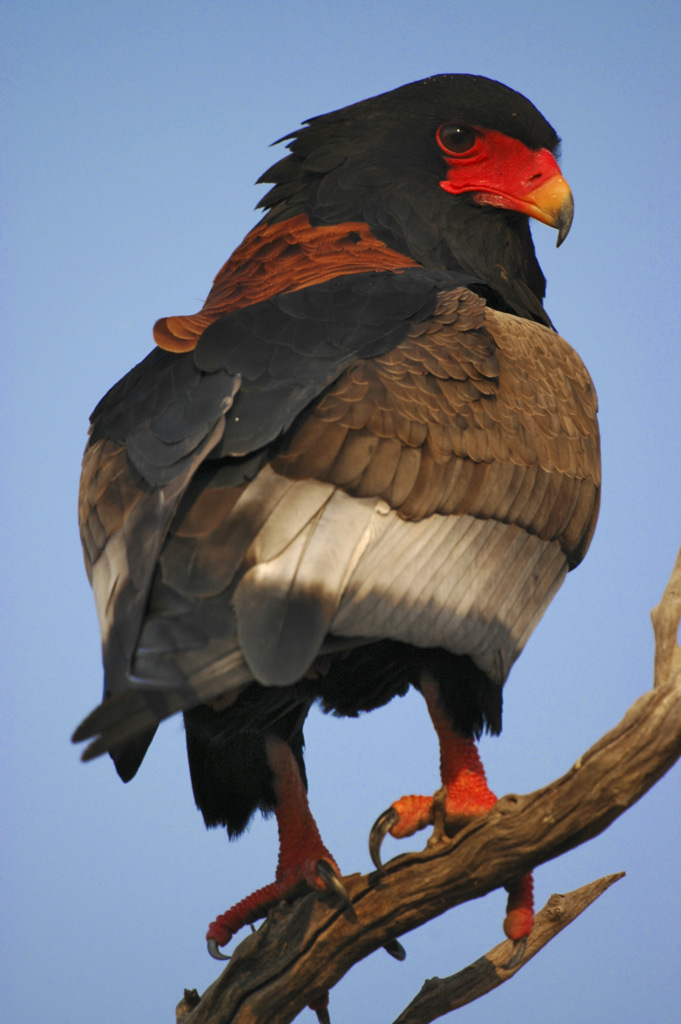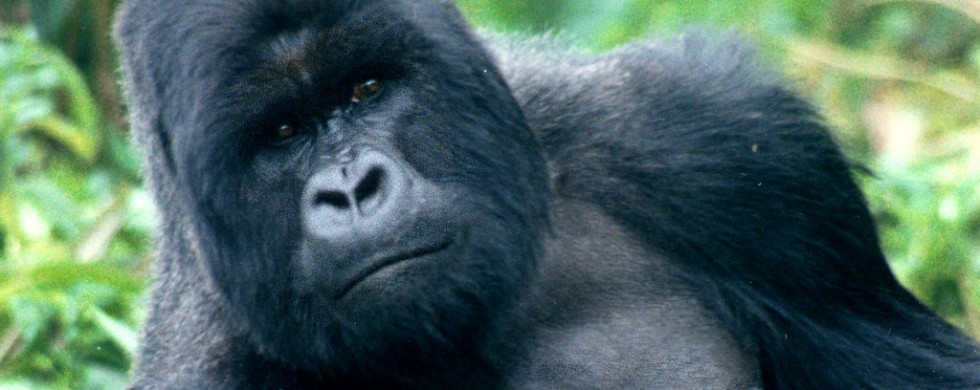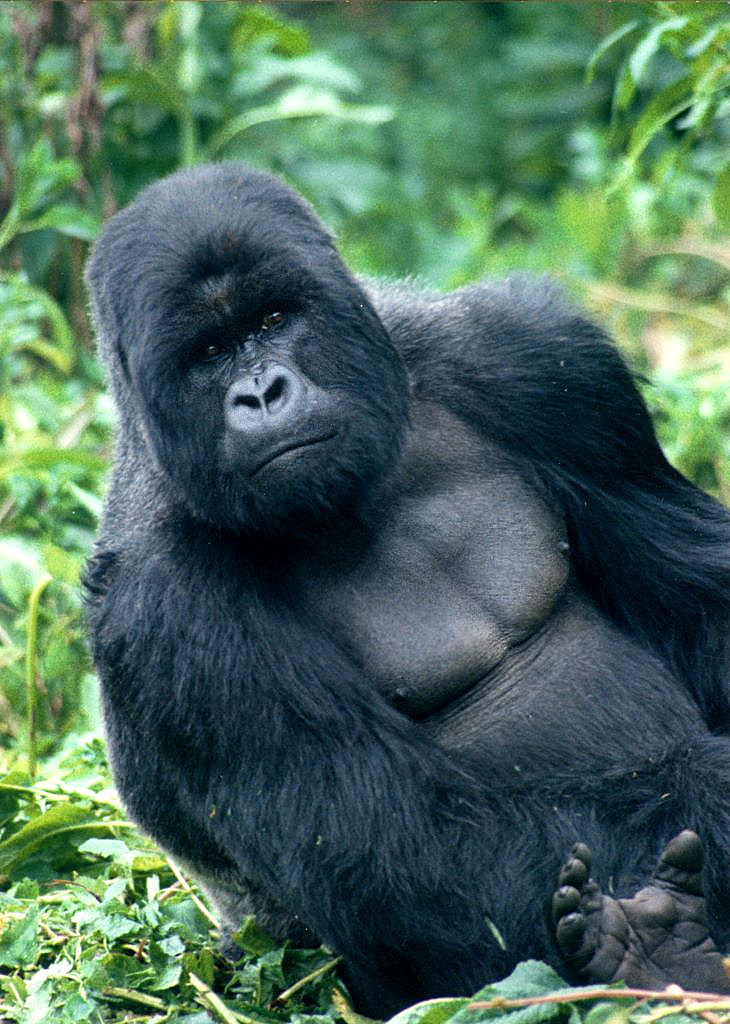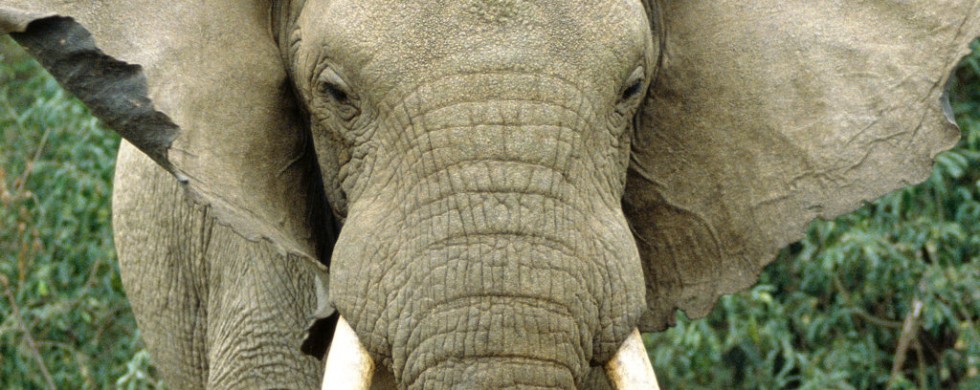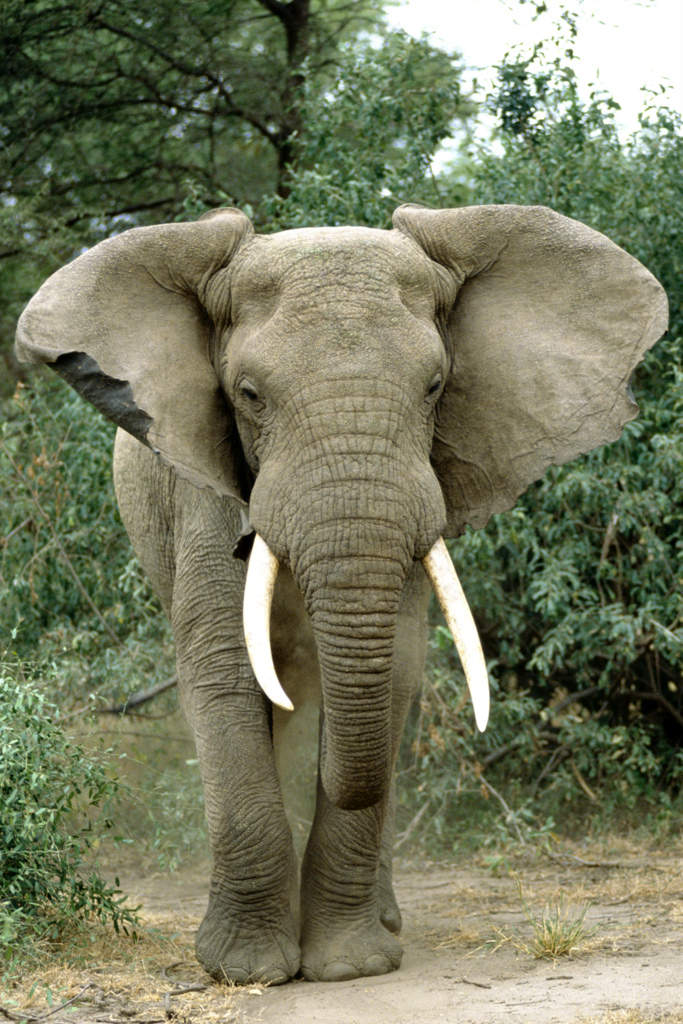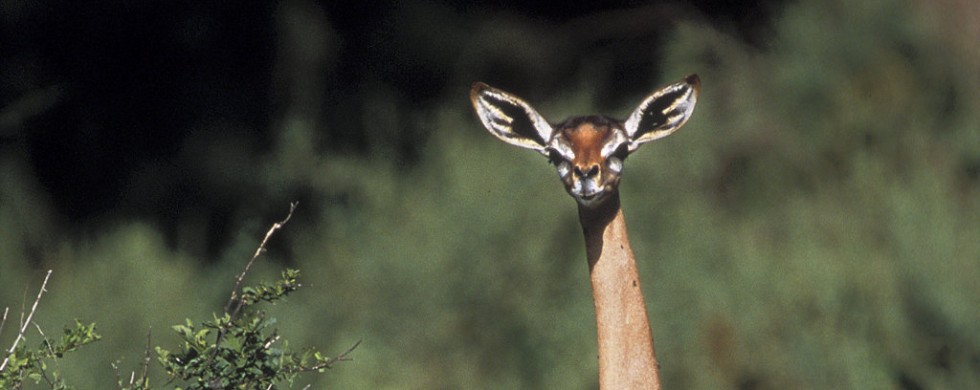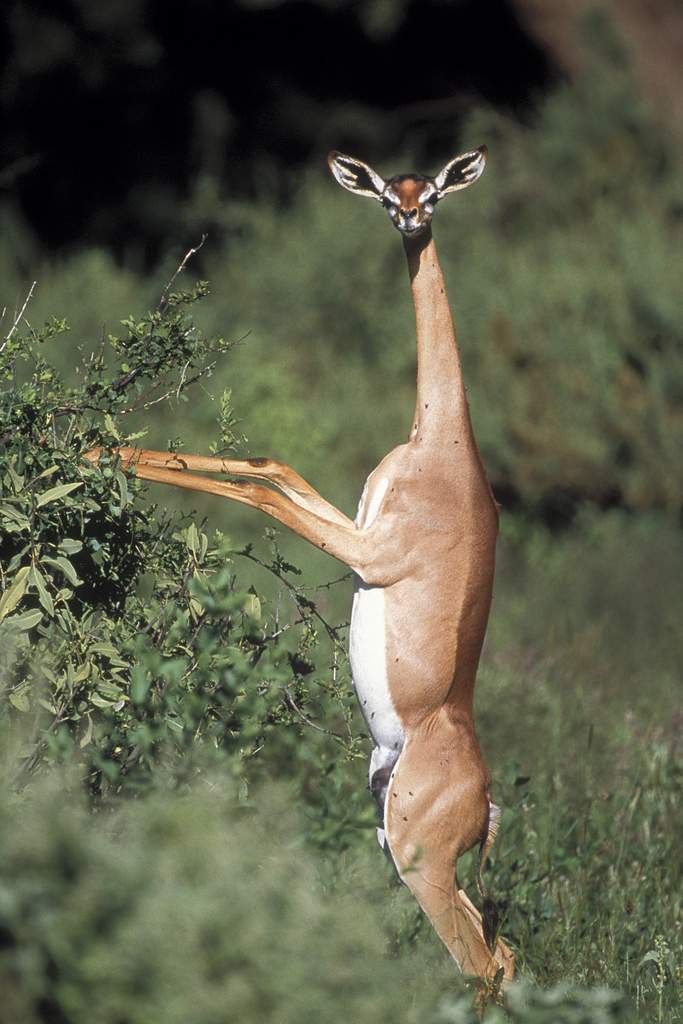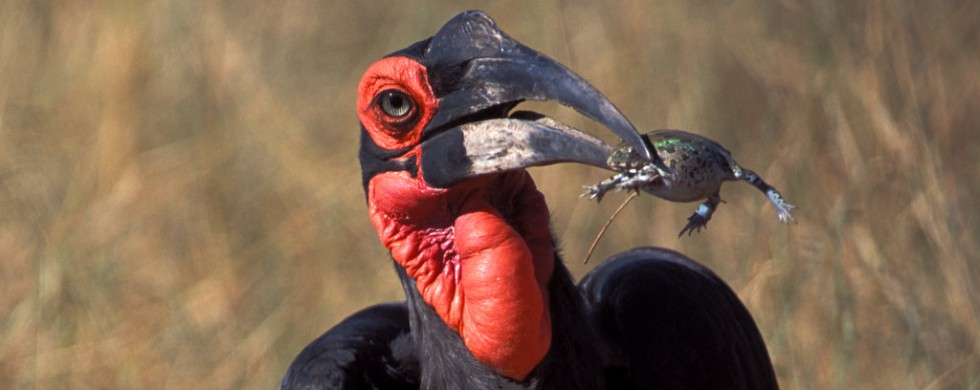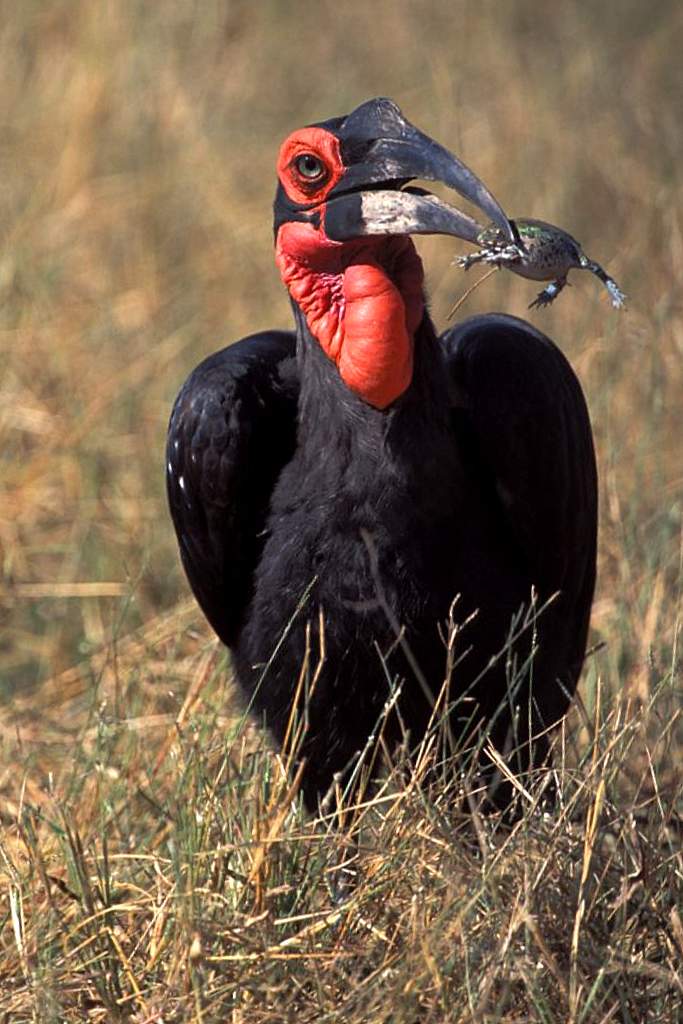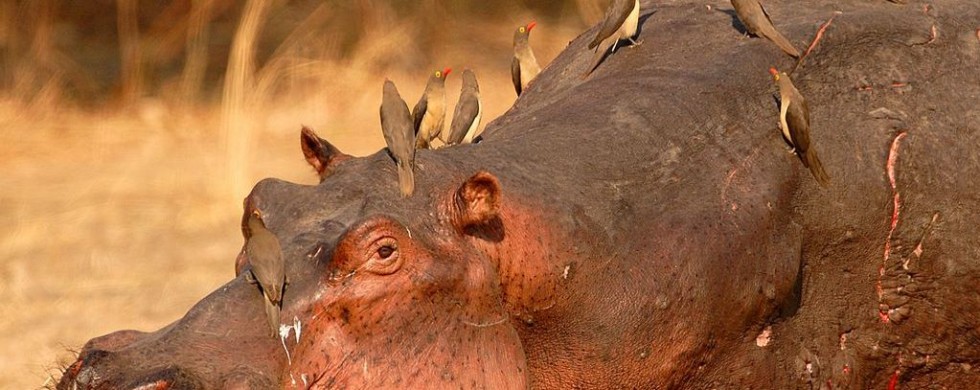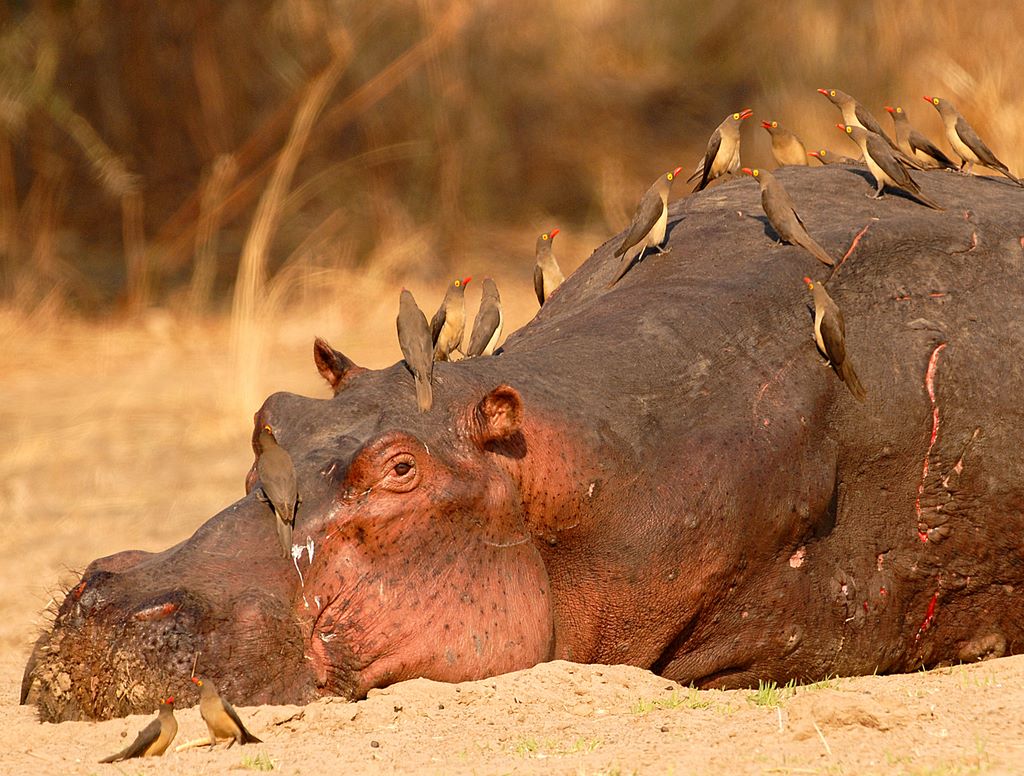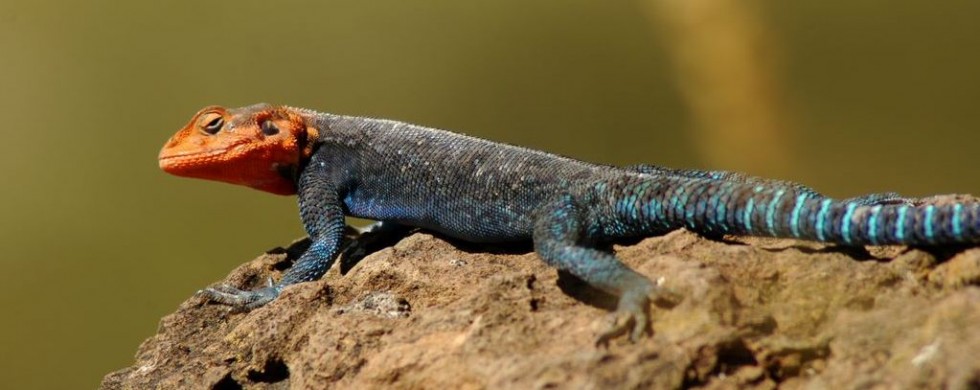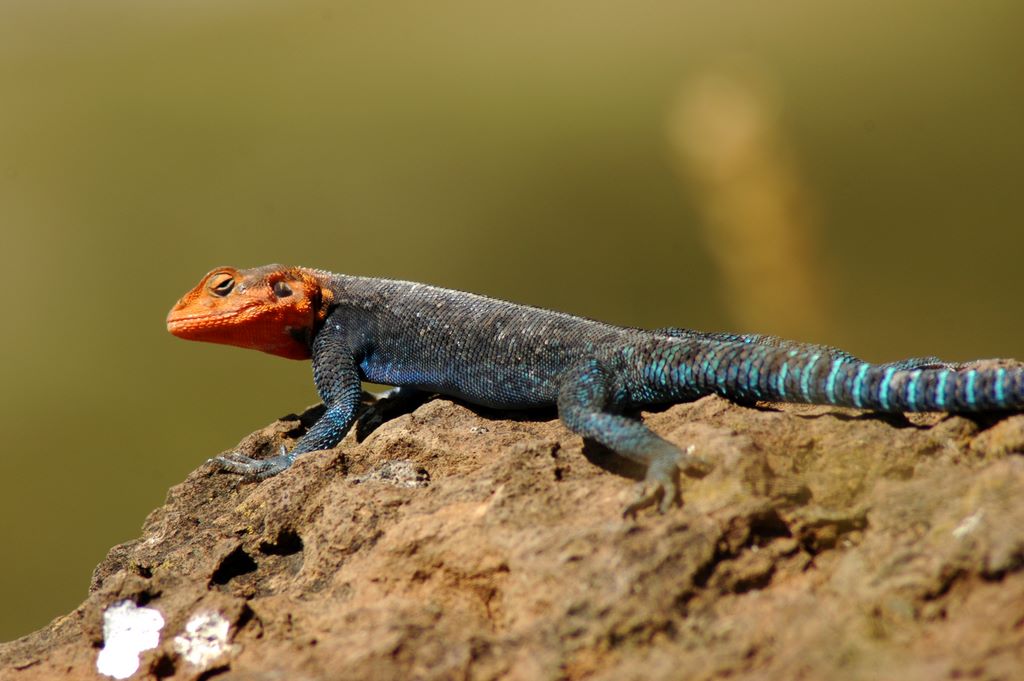15
Shot of the Month – December 2009
This month some celebrate the birth of the King of Kings. One Christmas story tells how three wise men were aided by a bright star that led them to the new King.
While less transcendent, three men (also less wise) were aided in finding the king of the animal world allowing me to capture this regal portrait of the male lion.
Our journey began on a crisp morning in Botswana as I, a visiting friend, and our guide/driver (the three wise-ish men) left camp in our Toyota Landcruiser (all out of camels) in search of royalty. After a few minutes on the trail, we heard the roar of a lion. We drove in that direction and found a young male lion walking with purpose. The young lion was agitated; he was clearly trying to find his missing pride.
Finally, after 20 minutes of plaintive calls and walking hither and thither, we heard a bellow off in the distance. Our young prince looked hopeful and called again and walked briskly in the direction of the deep roar. After another 10 minutes of the lion equivalent of “Marco Polo” the young lion led us to the magnificent black-manned lion in this photo. He was with a female and it was clear they were a mating couple. Their reunion was full of head bumps and body rubs. The animal lover in me reveled in the moment and the photographer in me went giddy as the sun finally rose above the horizon and an orange beam of light basked the lion in this heavenly glow. Click….sigh.
During this holiday season, I hope that you will likewise manage to reconnect with those dear to you and revel in the simple pleasure of being together. A warm head bump to you all.
(Speaking of great reunions. In 1969 two Australians living in the center of London bought a lion cub at Harrods department store. After a few months, it became clear that Christian, the lion, was becoming too big to live in the city. Rather than put him in a zoo they persuaded conservationist George Adamson (remember “Born Free”?) in Kenya to take Christian and teach him how to live in the wild. A year later the men returned to Africa to see how their now wild lion cub was doing. See the amazing reunion here )
15
Shot of the Month – November 2009
This month I offer this glam headshot of a Yellow Saddle-Billed Stork (SBS). Such a close-up of this bird is a rarity – they are solitary birds that don’t hang out in flocks and generally don’t like company. Most of my views of these storks have been at great distances and even then they often immediately turn and start walking in the opposite direction. As a photographer, this can be extremely frustrating given how stunningly they are adorned.
This stork is the sub-Saharan counterpart to Sesame’s Big Bird – they are the tallest stork in Africa and males can reach 5 feet in height and have a 9-foot wingspan. And the colorations! Where to begin? First, we have that massive brilliant red and black bill that is a great weapon for spearing fish, frogs, crabs, water beetles, etc. On top of the bill is a bright yellow plate that resembles the saddle you might find on a horse. Next, his face, neck, wings, and tail feathers are black while his back and chest are white. Finally, his legs are black but they are offset by reddish colored joints.
In this photo you can get a better view of his wild outfit:
This guy does not “blend.” (Any “My Cousin Vinny” fans out there?)
The male, as shown in the portrait, can be significantly larger than the female and has dark eyes and a bright yellow waddle on each side of the bill. Females have yellow eyes and no waddle. These storks are believed to mate for life and apparently have no arguments – SBSs have no muscles in their voice box so they are silent. Mating couples can communicate, however, by rattling their bills together.
It seems counterintuitive that such a solitary, shy, silent bird would be decked out in such a brilliant, ostensibly boastful display that demands notice and attention.
Another mystery of Mother Nature…
15
Shot of the Month – October 2009
The harbinger of success for some is acceptance into an exclusive club. Perhaps it is membership at an expensive golf course or getting the nod from the man with no neck to jump the line at that by-invitation-only nightclub.
Based on a news story I read in 2002 about devastating wildfires in Borneo I decided to fly to Borneo to try and see orangutans in the wild. Successful in my venture I became a member of a very exclusive club indeed. There is no salary quota, or star power fame required to join the club, simply the effort needed to journey up the Sekonyer River in the Tanjung Puting National Park in southern Borneo.
So what makes this club so special? Well, I may be among the last small group of humans to ever see an orangutan outside of a zoo. Orangutan means “man of the jungle” in the Malay language. In the last 20 years, we have destroyed 80% of all the forests they live in. On the island of Sumatra, the orangutan population has dropped 86% from what it was just 100 years ago and they are listed as “critically endangered.” The next status after critically endangered is “extinct.”
No jungle, no orangutan.
In Borneo, the orangutan is doing better and is only “endangered.” These two Malaysian islands are the last refuge of the only great ape not found in Africa.
The forests are being razed and cleared at an astonishing rate to provide the hardwoods we like for our furniture and to make way for palm oil plantations. We use palm oil in our cosmetics, in more and more processed foods, and increasingly, to make fuel for cars. People also like to have baby orangutans as pets so many are captured and killed in that pursuit.
Orangutans are the most intelligent creatures on the planet after humans (though given our behavior, I demand a recount). Of all the apes orangutans are the most arboreal – they spend most of their lives in the trees and rarely put a foot on the ground. Unlike most apes, orangutans do not live in social groups and spend the majority of their lives in solitude. Their arms are twice as long as their legs and they have opposable thumbs and opposable big toes so they can grasp with their feet as well.
Despite their lanky proportions, superhuman strength (at least 8 times stronger than man), and nifty opposable toes, I don’t think orangutans will be able to hang on much longer given our determined onslaught.
Our consumption here directly drives the loss of habitat there. If you want to learn more about how you can help, follow the link: http://www.mongabay.com/take-action/orangutans.html
Planet Earth Club
Members Only
(Non-Humans Need Not Apply)
15
Shot of the Month – September 2009
I have to admit that I am a bit shallow when it comes to my interest in birds – photographically, I am most interested in the pretty ones. True birders seek out all avian sizes and shapes and can be enraptured by a rare, but very dull, brown species of sparrow. I, on the other hand, only seek out colorful cranes, resplendent rollers, brilliant bee-eaters, or other alliterative combinations of bright-colored fowl.
While I admire the majestic nature of eagles and hawks most are hues of tan and browns and would look equally well in a black and white photo as well as one in color. There is one eagle however that makes a brilliant exception to this rule –the Bateleur Eagle. The Bateleur’s black head is strikingly offset by a red face and bill and the banded tan, white, and black body is accentuated by brilliant red legs and feet. For years I would often spot the bright red feet signaling from high up in a tree but invariably I could not get a shot as the rest of the body was hidden behind leaves and branches. I couldn’t believe my luck when I found this fellow with his mate, they pair for life, in a dead tree in Botswana. They were gracious enough to sit there for over an hour as I shot hundreds of images with nary a leaf or branch obstructing my view!
“Bateleur” is a French word that means “tightrope-walker” — in flight the Bateleur tips its wings from side to side, looking like a high-wire acrobat catching his balance. The eagle has a very short tail so this motion assists in making turns. The short tail however allows the Bateleur to do sideways barrel rolls and other spectacular aerobatics.
The eagle can spend eight to nine hours a day in the air searching for food and can cover up to 250 square miles looking for snakes, mice, birds, and carrion.
The Bateleur eagle has it all – noble in stature and form with striking crimson highlights — now that’s my kind of bird.
15
Shot of the Month – August 2009
I can say unabashedly that you haven’t fully lived until you have hiked through a misty, vine-covered jungle and gazed into the eyes of a Mountain Gorilla.
First, the setting is surreal. The jungle is an explosion of all things green. Every shade, hue, and likeness of green that you imagine surrounds you.
Jade. Olive. Pea. Pine. Kelly. Lime. Malachite. Sage.
Everything you encounter is a variation of green and whatever doesn’t move is padded in some form of emerald vine, plant, or moss. Rain is ever present as a downpour, a light drizzle, or as a misty shroud as passing clouds snag onto the mountain canopy.
Second, you cannot make eye contact with the mountain gorilla without a sense of awe. We share much of the same DNA and you cannot help but feel – see – experience, the intelligence of this creature. The gaze from an equal that is looking back at you with as much intrigue and awareness as might be found in any member of your group.
We are, in fact, two members of an exclusive group. The Hominidae, or “Great Apes” include chimpanzees, gorillas, humans, and orangutans. Sadly, only about 700 Mountain Gorillas remain in the world – all live in a shrinking area of forest found in the Virunga Volcanic Mountains at the intersection of Uganda, Rwanda, and the Democratic Republic of Congo. Their jungle is being cut down as humans encroach to take the trees for firewood or to make space for farming.
Soon there will be simply no space left on this planet for one of our closest family members. Can humanity find a way to live in balance with other beings on this planet?
If not, our existence will be much poorer because of it.
15
Shot of the Month – July 2009
If you peruse my website you may notice that I do not have a large number of photos of elephants. It’s not that I don’t like elephants, it’s just that I seem to have a hard time taking interesting photos of them. Elephants are large. And elephants are, well, grey. My images rarely seem to improve much on those basic facts.
This image is one of the rare exceptions. Here we have a bit of drama.
See those ears that have been flayed forward? This is a clear warning signal. He is telling us that he is not happy that we are in his space. He shook his head and flapped his ears again to make his point.
See that raised right foot? He is stepping forward, then back in a rocking motion — another signal that he would like us to go away.
We stayed a few minutes as I took some pictures and allowed my friends to see an elephant up close and personal. The elephant finally started moving in our direction and we had to back up and leave.
Ears out is polite elephant speak. If he pins them back, that is a signal that he is done with warning, and he is about to charge and you are about to become cartoonishly flat.
Elephants are among the most fascinating creatures on the planet. A few facts you can use at the next dinner party:
- Elephants are the largest land animals. Ok, everyone knew that, but did you know that the largest elephant ever recorded was shot in Angola in 1956 weighed 26,000 pounds, and stood 14 feet at the shoulder? Elephants typically weigh 7,000 to 13,000 pounds and stand about 3 feet shorter than that Angolan giant.
- Elephants are right or left-tusked. Their preferred tusk (the master tusk) will be shorter and more rounded at the end than the other.
- Elephants are the only mammal that can’t jump.
- Elephants can’t run either. They always have at least one foot on the ground. That being said they can still reach speeds of 25 mph!
- The elephant’s trunk has over 40,000 muscles. Yes, read that one again. With this remarkable tool, the massive beast can delicately pick up a single blade of grass. Or, it can rip off the branch of a tree.
We’ve only scratched the surface. Elephants have other amazing physical attributes, are incredibly intelligent, and live in very complex social structures. All to be explored in future shots of the month.
Now I need to get out there and get some photos that do these extraordinary creatures justice.
Until next month…:-)
15
Shot of the Month – June 2009
I have a collection of photos on my wall at home and at work. At times visitors or friends come by and walk along the wall and review the collection.
Some of the images provoke “ooohs and ahhhs.” Others make people laugh or smile. Some get an “eewwh” – well, some lion shots can get a little bloody, for example.
When people discover this image it tends to induce a small skit:
- Slowly walking, glance at the photo. Small recoil followed by a double take.
- Walk back and get in close for a good look. Squint a bit. Peer from the right. Now from the left
- Turn and look back at me: “What in the world is that?” or “Is that real?”
Yep, it is indeed real, and no, I did not shrink his head using some software tricks. It is all genuine and it is a Gerenuk.
Gerenuks are a type of antelope that lives in the arid regions of East Africa, typically found in eastern Kenya and Ethiopia, and parts of Somalia. The word Gerenuk comes from the Somali and means “giraffe-necked.”
What we have here is another example of keen adaptation to one’s surroundings. Changes in their spine, muscles, and bone structure allow the Gerenuk to stand up straight on its hind legs. This unique behavior, and that long neck, allow the species to exploit a very precise feeding niche. Giraffes have the tops of trees covered, while shorter antelopes and gazelles like Dik Dik, Thomson’s Gazelle, and Impala eat at the bottom half of bushes. Gerenuks saw an opportunity and adapted – by standing up and stretching their necks they can reach leaves that are six to eight feet off the ground – a feeding zone that few others can reach.
Gerenuks live in arid regions where water is scarce. Turns out that they can go months without drinking water by being very selective about what they eat. Gerenuks only eat the newest shoots and most succulent leaves of bushes and trees, often reaching into the middle branches to find the finest morsels. They also eat buds, flowers, and fruit, but they do not eat grass. This fastidious diet allows them to get all the moisture they need without drinking water and thrive in habitats where few animals can. Smart (and tasty).
While many are shocked to learn of such a beast, it seems that they have been around for a long time. Although European scientists did not discover the Gerenuk until 1898, drawings of these otherworldly creatures can be found in Egyptian art from 5600 B.C.
Hmmn, alien-looking creature. Found in Egyptian art. Some people think the pyramids could only have been built with the help of aliens. Do you think that maybe Gerenuks were, well, you know…..ok, never mind. Forget I mentioned it.
Be like a Gerenuk – find your niche and prosper.
15
Shot of the Month – May 2009
This image captures a life-and-death struggle – at least for the frog. I almost missed this epic battle – we originally stopped the vehicle to observe the spectacle of a hawk plucking and dining on a bird it had recently caught. After watching the hawk for a few minutes I started to scan the horizon – I have learned over the years that any time you stop, always take the opportunity to take in the 360° around you. You never know what you might find.
As I looked behind the vehicle, off in the distance I saw a group of Southern Ground Hornbills approaching. These large birds, about the size of turkeys, travel in groups of 2 to 7 and spend much of their time walking along looking to eat any small reptile, insect, or mammal they might scare up. The ground hornbill stumbled upon this frog and prepared to have lunch.
But the frog was not going down without a fight. If you look closely you will see that the frog has inflated himself. In this state the bird cannot swallow him – the frog is too big. Undeterred, the hornbill threw the frog to the ground and pecked at him a few times. He was trying to poke a hole in the frog’s skin so the “frog balloon” could not fill with air!
He picked the frog up. The frog puffed himself up again. No luck.
Try again. Peck. Peck. Peck. Pick up the frog. Inflate.
Peck. Peck. Peck. Inflate. Peck. Peck. Peck. Inflate.
This marathon battle lasted a good 5 to 7 minutes. Alas, at last, all the pecking had taken its toll on the frog and he could no longer inflate himself. Ironically, just as this happened, one of the other ground hornbills in the group walked over, snatched up the frog off the ground, tossed him in the air, and swallowed him whole. Gulp.
The interloper had snatched defeat (or in this case, “defrog”) from the jaws of victory.
(moan) 🙂
15
Shot of the Month – April 2009
Ever had friends come over to the house and they just wouldn’t leave? You just wanted to go to bed but they just keep chatting away, having a grand ol’ time. The look on the hippo’s face reminds me of that exasperated feeling.
“Shhh, don’t look, but are they gone yet?”
So, what is going on here? Why is this hippo out on land? Why by himself? And why covered in, uh, birds?
I came upon this hippopotamus near the Luangwa River in South Luangwa National Park, Zambia. This gigantic male is lying on a sandy flood plain above the water surface – in the rainy season he would actually be underwater, but at this time, during the dry season, the river has descended into its deepest channel and is a good 20 feet below where he is resting.
Why is he out on land? Turns out it is not as uncommon as most postcard images would have us think. Every evening hippos emerge from the water and walk up to five miles to graze on short grass across the countryside. Hippos will also bask in the sun during the day for short periods (gotta break up all that napping somehow).
Why is he by himself? Although the classic African scene is that of a group of hippos, a “pod” for those of you keeping track, lounging along the river’s edge, it turns out that hippos are not social animals. They do not develop social bonds with the other members of the pod and scientists don’t really know why they huddle together. Perhaps, they are just following the old adage of “safety in numbers.”
And why is he covered with birds? These are Red-billed Oxpeckers. Despite the somewhat annoyed look on the hippo’s face, he actually welcomes their presence as they provide a valuable service. Oxpeckers pick off ticks and other annoying insects that can’t be reached otherwise.
But there is more to this story. Hippos are very aggressive and males often fight each other for dominance. If you look closely this huge male is covered in fresh, open wounds. My hunch is that he was in a vicious brawl the night before and didn’t fare too well. Exhausted, bloodied, and bruised he took refuge up on the raised bank of the river to rest and heal in peace. The oxpeckers, looking for a free meal, will continually check the wounds for insects and help keep them pest-free. Everybody wins, right?
Well, some scientists now believe that the oxpeckers, in fact, may also peck at the wounds to keep them open so they can drink the blood directly, thereby delaying the healing process. So, depending on the situation, the hippo-ox pecker relationship may be “symbiotic” and in other situations “parasitic.”
Or in less zoological terms, sometimes oxpeckers act like Florence Nightingales (get it?) and other times they act like feathered vampires. At this point, no one knows for sure where the truth lies.
Life is complicated……
15
Shot of the Month – March 2009
You gotta respect the attitude of this colorful fellow. It’s as if he is glancing over at us and cooling asking “And what, exactly, are you doing on my rock?” This would be attitude a la Agama – agama lizard to be precise.
Unlike many creatures on my website, agama lizards are far from being endangered. I have seen them in Gabon in West Africa, in Kenya and Tanzania in East Africa, and in most places in between. There are 31 species of agama lizard spread out across Africa.
In my first visit to Africa, as a Peace Corps volunteer, we called them the “push-up lizards.” Why? Well, the males, that would be the colorful ones, have this habit of running hither and thither, stopping abruptly, and for what seemed to be for no apparent reason would start to do push-ups. Of course, we all know now that this is all about boys being boys – the males were trying to show off to the lady lizards and/or scare off rival males. By bobbing up and down they were trying to appear larger than they really are.
Agama lizards live in a very hierarchical world. In a given space the most colorful agama will be the dominant male or “cock.” Subordinate males adopt a dull brown color. A dominant male can have up to six females in his territory for breeding. We’ve all seen lizards splayed on rocks basking in the sun–even this has its rules in Agama land. You will find the dominant male at the highest position on the rock, followed next by the sub-males, and lowest on this literal totem pole you will find the females.
Male agama lizards will fight each other to hold or take over a territory. A challenger will present himself in full splendid Technicolor – a visual cue that he is here to rumble. It is a scene many of us can recall from high school dances or from often repeated scenes at the local bar. First, the two rival males make eye contact – brows furrow. Soon there is a lot of huffing and puffing at a safe distance. Then the head bobbing thing. Then full body push-ups. If the challenger has not fled away or returned back to monochromatic servitude then the dominant male will charge closer to within a few inches. More bobbing. Finally the two charge each other, and then, well, and then they flip around in opposite directions. Have they lost their nerve? No, facing away from each other, tail to tail, allows the sword, uh, tail fighting to begin. They lash at each other until one is sufficiently pummeled and flees. Apparently, some biting can also occur, but that seems rather unmanly to me.
So there you have it, the glorious, albeit ridiculous, agama lizard – the life form that high school jocks come back as in their next life. (For those who believe in reincarnation)
Until next month… 🙂

